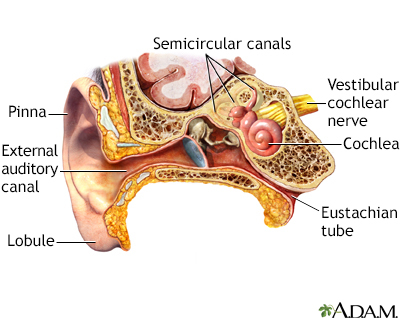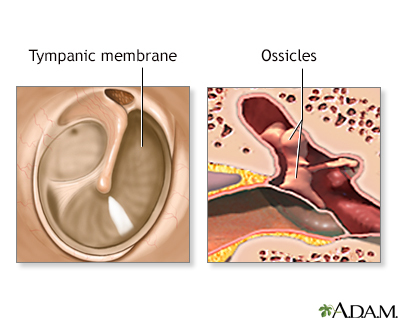Ear discharge
Definition
Ear discharge is drainage of blood, ear wax, pus, or fluid from the ear.
Alternative Names
Drainage from the ear; Otorrhea; Ear bleeding; Bleeding from ear
Causes
Most of the time, any fluid leaking out of an ear is ear wax.
A ruptured eardrum can cause a white, slightly bloody, or yellow discharge from the ear. Dry crusted material on a child's pillow is often a sign of a ruptured eardrum. The eardrum may also bleed.
Causes of a ruptured eardrum include:
- Foreign object in the ear canal
- Injury from a blow to the head, foreign object, very loud noises, or sudden pressure changes (such as in airplanes)
- Inserting cotton-tipped swabs or other small objects into the ear
- Middle ear infection
Other causes of ear discharge include:
- Eczema and other skin irritations in the ear canal
- Swimmer's ear with symptoms such as itching, scaling, a red or moist ear canal, and pain that increases when you move the earlobe
- Normal ear wax
Home Care
Caring for ear discharge at home depends on the cause.
When to Contact a Medical Professional
Contact your health care provider if:
- The discharge is white, yellow, clear, or bloody.
- The discharge is the result of an injury.
- The discharge has lasted more than 5 days.
- There is severe pain.
- The discharge is associated with other symptoms, such as fever or headache.
- There is loss of hearing.
- There is redness or swelling coming out of the ear canal.
- Facial weakness or asymmetry
What to Expect at Your Office Visit
The provider will perform a physical exam and look inside the ears. You may be asked questions, such as:
- When did the ear drainage begin?
- What does it look like?
- How long has it lasted?
- Does it drain all the time or off-and-on?
- What other symptoms do you have (for example, fever, ear pain, headache, or hearing loss)?
The provider may take a sample of the ear drainage and send it to a lab for examination.
The provider may recommend anti-inflammatory or antibiotic medicines, which are liquid drops placed in the ear. Antibiotics may be given by mouth if a ruptured eardrum from an ear infection is causing the discharge.
The provider may remove wax or infectious material from the ear canal using a small vacuum suction.
Gallery


References
Hathorn I. The ear, nose and throat. In: Innes JA, Dover AR, Fairhurst K, eds. Macleod's Clinical Examination. 14th ed. Philadelphia, PA: Elsevier; 2018:chap 9.
Kerschner JE, Preciado D. Otitis media. In: Kliegman RM, St. Geme JW, Blum NJ, Shah SS, Tasker RC, Wilson KM, eds. Nelson Textbook of Pediatrics. 21st ed. Philadelphia, PA: Elsevier; 2020:chap 658.
Pelton SI. Otitis externa, otitis media, and mastoiditis. In: Bennett JE, Dolin R, Blaser MJ, eds. Mandell, Douglas, and Bennett's Principles and Practice of Infectious Diseases. 9th ed. Philadelphia, PA: Elsevier; 2020:chap 61.
Wareing MJ, Warner E. Ear, nose and throat. In: Glynn M, Drake WM, eds. Hutchison's Clinical Methods. 25th ed. Philadelphia, PA: Elsevier; 2023:chap 22.